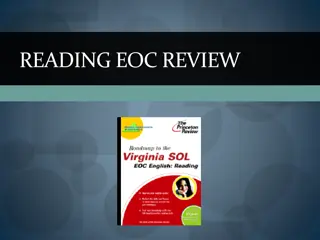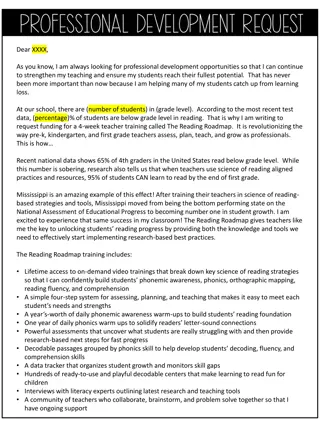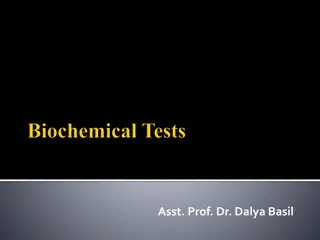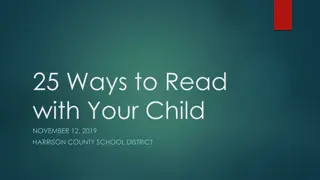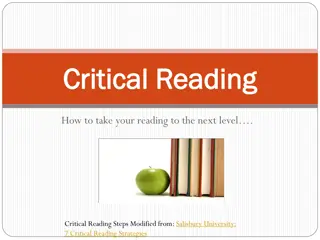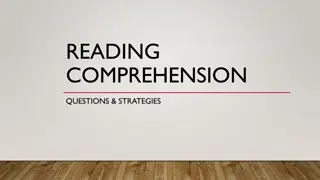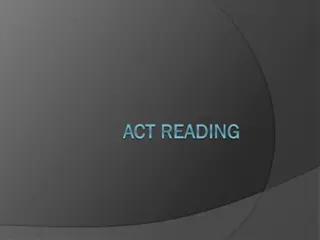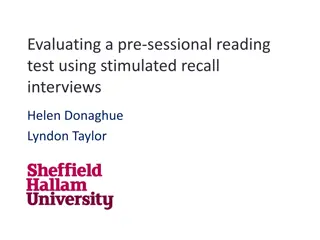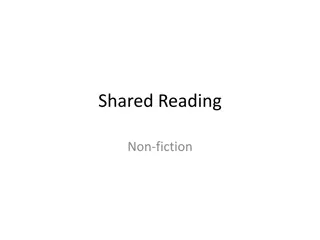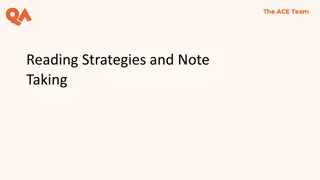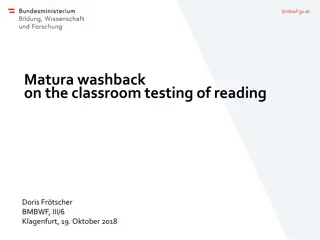Understanding the ACT Reading Test Content
The ACT Reading Test comprises 40 questions to be answered in 35 minutes, covering four categories: Prose Fiction, Humanities, Social Sciences, and Natural Sciences. Each category has a specific percentage of questions. The test evaluates your ability to comprehend various passages, including prose fiction, humanities, social sciences, and natural sciences, without requiring prior knowledge of the subjects but focusing on attentive reading and critical thinking.
Download Presentation

Please find below an Image/Link to download the presentation.
The content on the website is provided AS IS for your information and personal use only. It may not be sold, licensed, or shared on other websites without obtaining consent from the author. Download presentation by click this link. If you encounter any issues during the download, it is possible that the publisher has removed the file from their server.
E N D
Presentation Transcript
ACT READING TEST 40 questions 35 minutes
CONTENT OF TEST READING CONTENT PERCENT # OF QUESTIONS Prose Fiction 10 25% Humanities 25% 10 Social Studies 10 25% Natural Sciences 25% 10 Total 100% 40
FOUR CATEGORIES Prose Fiction Passages from short stories or novels
HUMANITIES Architecture, Art, Dance, Ethics, Film, Language, Literary Criticism, Memoir, Music, Personal Essays, Philosophy, Radio, Television, Theater
SOCIAL SCIENCES Anthropology, Archaeology, Biography, Business, Economics, Education, Geography, History, Political Science, Psychology, Sociology
NATURAL SCIENCES Anatomy, Astronomy, Biology, Botany, Chemistry, Ecology, Geology, Medicine, Meteorology, Microbiology, Natural History, Physiology, Physics, Technology, Zoology
READING TEST SCORE ARTS/LITERATURE SUB SCORE SOCIAL STUDIES/SCIENCE SUB SCORE About 8 8 minutes to read each passage and answer the questions that follow 35 minutes to read the passages and answer 40 multiple choice questions
What am I being tested on? The reading test evaluates your ability to understand the passages that appear in the test. It does not test your ability to remember relevant facts from outside the passage. You don t need to be knowledgeable about the subject matter, but you do need to read attentively and think carefully about what you read.
PROSE FICTION Passages generally include: Narration of events Revelation of character Plot, characters, mood Be aware of mood or tone, relationships of the characters, emotion implied by what characters say and how they say it
HUMANITIES Humanities passages describe or analyze ideas or works of art. They are written as fact: present information, pay attention to author and point of view may have to project the author s likely response identify relationships between events, ideas, people, trends or modes of thought
SOCIAL STUDIES Social Studies passages typically present information gathered by research: Names, dates, concepts Cause-effect, comparisons, sequence of events Watch the specifics as they relate to the overall idea
NATURAL SCIENCES Presents a science topic and an explanation of the topic s significance Relationships between natural phenomena, not relationships between characters Cause-effect relationships, comparisons, sequences of events May include specialized or technical language. The passage will provide clues to their meaning.
General Types of Questions Identify and interpret details Determine the main idea of a paragraph or passage Understand relationships compare/contrast Understand cause-effect
Types of Questions cont. Make generalizations Determine the meaning of words from context Understand sequences of events Draw conclusions about the author s voice and method
Strategies Use the time allotted. Pace yourself. If you take 2-3 minutes to read each passage you ll have about 35 seconds to answer each question. Some will take less time which gives more time for the challenging ones. Think of test as four 8 units and try to complete all the questions for a passage in that time.
Strategies continued There are short paragraphs with subject headings before each passage. Read these. They tell you the subject matter, where the passage is from, who wrote it, and a little information about it. Remember the questions can all be answered based only on the material in the passage. Don t rely too much on your own background knowledge.
Find your own Strategy Read each question carefully, so you know what is being asked. Some people like to answer the easier questions first, then go back to the more difficult ones. Most experts believe you should answer all questions related to one passage before moving on. Try to eliminate choices you re certain are incorrect. Refer back to the passage.
Overall Tips Look for the best answer, but read and consider all of the options. Ask yourself whether you can justify your choice as the best answer. Answer ALL the questions, you re not penalized for guessing. MARK UP YOUR TEST BOOK!
OMG! I cant read that fast! The vast majority of people can NOT read all of the passages in allotted amount of time so don t panic. Most people find the ? s on first passage the hardest (inference ? s on a prose passage) Most people find the final passage the easiest (basic ? s on a science passage) But most people do NOT get to the final passage.
Possible Approaches? Are you one of the many people who can NOT read that fast? Is this general trend of #1 being the most difficult and #4 being the easiest true for you? If so, you could START w/ passage 2, go to 3, go to 4, and then finish w/1 (knowing that is the one you may run out of time on) Don t leave any blank and don t mess up #s
Practice Tests Will See What is best for you
Lets do a COLD Speed Test and then try it again using a couple of tricks.
THE GOSPEL OF SPEED READING he text. ck up the book. Reading at a 45-degree angle is easier on the eyes than off a flat surface. Never read without a pen. By moving the tip of a pen beneath a line, your eyes will instinctively follow, speeding you up. On a computer, run the onscreen cursor under the text. Pick up the book. Reading at a 45-degree angle is easier on the eyes than off a flat surface. Relax your eyes. Focus on full lines, not specific words, using peripheral vision. Move your head, and pay attention to the upper half of letters. Kill that voice in your head. Silently repeating words slows you down. To break the habit, try quietly humming. Keep on moving. Resist the urge to "regress" and reread. Relax your eyes. Focus on full lines, not specific words, using peripheral vision. Move your head, and pay attention to the upper half of letters. Kill that voice in your head. Silently repeating words slows you down. To break the habit, try quietly humming. Keep moving. Resist the urge to "regress" and reread.
THE SCIENCE BEHIND SPEEDREADING You must minimize the number and duration of fixations per line to increase speed You must eliminate regression and back-skipping to increase speed. You must use conditioning drills to increase horizontal peripheral vision span and the number of words registered per fixation. Tim Farriss fourhourworkweek.com/blog/


